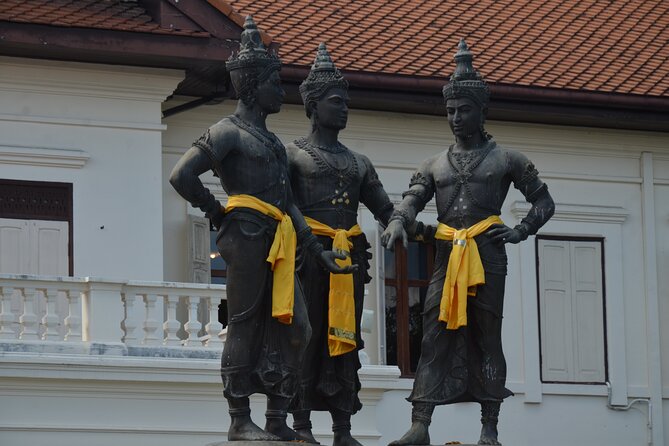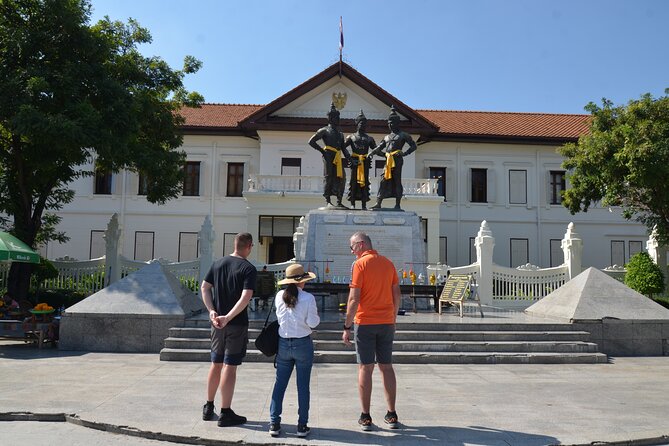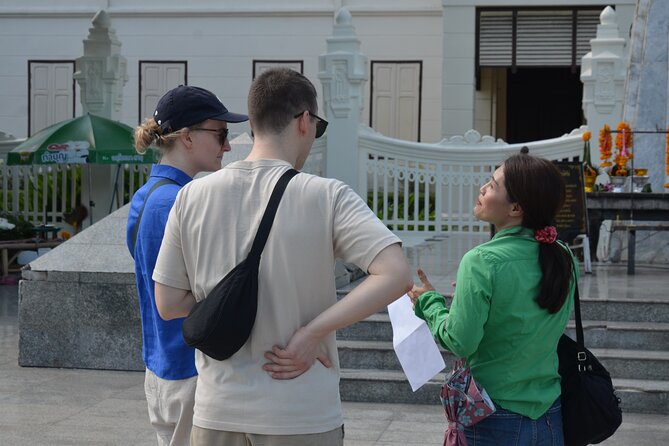Chiang Mai’s Historical and Cultural Highlights Walking Tour promises an immersive journey through the city’s captivating past. Embarking from the iconic Three Kings Monument, participants uncover the architectural marvels of Wat Phra Singh and Wat Chedi Luang, delving into the Lanna kingdom’s rich heritage. As the tour progresses, visitors engage with local artisans, uncovering the cultural narratives that have shaped this vibrant northern Thai city. The experience culminates at the serene Wat Chiang Man, the oldest temple in Chiang Mai, leaving participants with a deeper appreciation for the region’s enduring traditions. Prepare to be captivated by the unique blend of history, art, and community that defines this walking tour.
Good To Know

- Discover Chiang Mai’s rich heritage by exploring iconic temples like Wat Phra Singh, Wat Chedi Luang, and Wat Chiang Man, showcasing Lanna architectural styles.
- Gain insights into the cultural significance of these temples, which have played crucial roles in shaping the city’s identity and spiritual legacy.
- Experience the vibrant local atmosphere by immersing in bustling markets, artisan workshops, and engaging with the community to understand Chiang Mai’s character.
- Appreciate the intricate craftsmanship and artistic expressions evident in the temples’ architecture, murals, and carvings, reflecting the ingenuity of Lanna artisans.
- Trace the historical narratives of Chiang Mai’s golden age through the tour, connecting the city’s past to its present and fostering a deeper understanding of its cultural evolution.
Meeting at the Three Kings Monument

Where do participants meet for this walking tour in Chiang Mai?
The meeting point is the Three Kings Monument, located on Prapokkloa Road in the Si Phum district.
This iconic landmark, featuring statues of the three legendary kings who founded the Lanna Kingdom, serves as the starting point for the historical and cultural exploration.
Travelers should arrive at the Three Kings Monument, a central and easily accessible location, to begin their immersive walking experience through the charming streets and ancient temples of Chiang Mai.
From this strategic starting point, the tour will guide participants through the city’s rich heritage and captivating sights.
If you're enjoying exploring Chiang Mai on foot, you'll love these other walking tours we recommend
Exploring Wat Phra Singh

From the iconic Three Kings Monument, the walking tour proceeds to explore the magnificent Wat Phra Singh, one of the most significant Buddhist temples in Chiang Mai.
Founded in the 14th century, the temple’s exquisite architecture blends Thai and Lanna styles, with intricate carvings and golden embellishments adorning the roofs and buildings.
Visitors marvel at the elaborate Ubosot, or ordination hall, with its impressive murals depicting scenes from Buddhist scriptures.
The tour guide provides insightful commentary, highlighting the temple’s rich history and cultural significance.
Wandering through the serene grounds, participants gain a deeper appreciation for Chiang Mai’s spiritual and artistic heritage.
The Grandeur of Wat Chedi Luang

The walking tour then leads participants to the majestic Wat Chedi Luang, a 14th-century temple renowned for its colossal stone chedi (stupa) that once stood over 300 feet tall. This architectural marvel, now partially restored, showcases the grandeur of Lanna-style Buddhist architecture. Visitors are captivated by the intricate carvings and the serene atmosphere that permeates the temple grounds.
| Feature | Description |
|---|---|
| Chedi | Massive stone structure, originally over 300 feet tall |
| Architecture | Lanna-style, with intricate carvings and details |
| Atmosphere | Serene and peaceful, inviting contemplation |
| Restoration | Ongoing efforts to preserve the historical site |
| Significance | Prominent landmark in Chiang Mai’s cultural heritage |
Traditional Lanna Architecture and Design
As the walking tour moves beyond the magnificent Wat Chedi Luang, participants gain a deeper appreciation for the distinct architectural style that defines the Lanna culture of northern Thailand.
Characterized by sloping roofs, ornate gables, and intricate woodcarvings, Lanna architecture showcases the region’s rich artistic heritage. Visitors marvel at the intricate patterns and vibrant colors that adorn the temples and historic structures, reflecting the influence of Burmese, Tai, and Khmer design elements.
The tour guide expertly explains how these architectural elements evolved over centuries, shaping the unique identity of Chiang Mai’s built environment.
Participants leave with a newfound respect for the ingenuity and creativity of Lanna artisans, whose work continues to captivate and inspire.
Cultural Significance of the Temples

Intricately woven into the fabric of Chiang Mai’s cultural heritage, the city’s temples hold profound significance for the local populace and visitors alike. These sacred spaces offer a window into the region’s ancient beliefs, traditions, and artistic expressions. As participants explore the hallowed grounds, they gain a deeper understanding of the Buddhist faith and its enduring influence on daily life. The temples’ intricate architecture, ornate murals, and revered relics serve as tangible reminders of the area’s rich history and the reverence held for spiritual enlightenment.
| Temple | Architectural Style | Cultural Significance |
|---|---|---|
| Wat Phra Singh | Lanna | Revered for its 14th-century Buddha statue and role as a center of monastic learning |
| Wat Chedi Luang | Lanna | Iconic chedi (stupa) serves as a landmark and symbol of Chiang Mai’s heritage |
| Wat Chiang Man | Lanna | Oldest temple in Chiang Mai, founded in the 13th century, showcases traditional Lanna design |
Fascinated by Chiang Mai's past? More historical tours we've covered
- Bike Historic Old City Chiang Mai – Active Day Tour
- Chiang Mai: Historic Old City 4-Hour Guided Bike Tour
- From Chiang Mai: Customize Your Own Sukhothai Heritage Tour
- Chiang Mai: History & Mouth Watering Food Tour
- Chiang Mai: Guided Historical City Tour by Bike With Lunch
- 1 Day Sukhothai Historical Park From Chiang Mai Private Tour
Taking in the Local Atmosphere
Beyond the grand temples, the walking tour offers an immersive experience in Chiang Mai’s vibrant local atmosphere.
Strolling through the charming streets, visitors will encounter the rhythms of daily life – bustling markets, artisan workshops, and friendly interactions with locals. The tour guides share insights into the culture, inviting participants to observe and engage with the community.
From the sights and sounds to the aromas of local cuisine, this experience provides a genuine connection to Chiang Mai’s distinctive character.
Whether bargaining at a lively night market or observing craftspeople at work, travelers are invited to step into the heartbeat of this captivating city.
Embracing the Historical Narratives
The walking tour in Chiang Mai skillfully weaves together the city’s rich historical narratives, immersing visitors in captivating stories that have shaped its enduring character.
Guides bring to life the legends and traditions surrounding the magnificent Wat Phra Singh and Wat Chedi Luang, two of the tour’s highlights. Visitors learn about the kingdom’s golden age and the region’s strategic importance throughout history.
The tour expertly connects the past to the present, fostering a deeper understanding of Chiang Mai’s evolution and the cultural influences that have contributed to its unique identity.
This immersive experience allows travelers to embrace the city’s historical significance and appreciate its living heritage.
Concluding at Wat Chiang Man
The walking tour concludes at Wat Chiang Man, a revered Buddhist temple that stands as a testament to Chiang Mai’s long and storied past.
This 13th-century temple is one of the oldest in the city and features intricate carvings, a stunning chedi, and a serene ambiance that invites visitors to pause and reflect.
As the tour group explores the temple’s grounds, they’ll learn about its history, significance, and the role it has played in shaping Chiang Mai’s cultural identity.
With a newfound appreciation for the city’s rich heritage, participants depart the tour with a deeper understanding of Thailand’s northern capital and its enduring spiritual legacy.
Frequently Asked Questions
Can I Request a Modification to the Tour Itinerary?
Requesting modifications to the tour itinerary is possible, but depends on the availability of the tour guides and other logistical factors. Clients should contact the tour operator in advance to discuss any desired changes.
Are There Any Age Restrictions for the Tour?
The tour does not have any specific age restrictions. However, it’s not recommended for infants, as they must sit on laps during the tour. Most travelers can participate, though those with medical conditions should exercise caution.
What Should I Bring for the Walking Tour?
For this walking tour, you’ll want to bring comfortable walking shoes, sun protection like a hat and sunscreen, and a small backpack or bag to carry any purchases or personal items. The tour company provides bottled water.
Is Photography Allowed During the Tour?
Yes, photography is allowed during the tour. Participants are encouraged to capture the historical and cultural sights they’ll experience. However, it’s polite to ask for permission before photographing people.
Can I Purchase Souvenirs at the Temples?
Yes, visitors can purchase souvenirs at the temples during the tour. Most temples have small shops or stalls selling traditional Thai crafts, religious items, and other locally-made products that make great souvenirs.
Sum Up
The Historical and Cultural Highlights Walking Tour in Chiang Mai offers a captivating exploration of the city’s rich heritage. Visitors will enjoy the architectural wonders of Wat Phra Singh and Wat Chedi Luang, interact with local artisans, and uncover the compelling narratives that have shaped Chiang Mai’s history, culminating at the serene Wat Chiang Man, the oldest temple in the city.
More Walking Tours in Chiang Mai
More Tours in Chiang Mai
- Ex-Monk City & Temples Walking Tour: (3.5 Hours / 1.7 Km.)
- Chiang Mai: Historic Temples and City Guided Walking Tour
- Chiang Mai : Sticky Waterfall (Half Day Tour) Hotel Transfer
- Chiang Mai:Wat Phra That Doi Suthep & Wat Umong Evening Tour
- Chiang Mai: Doi Suthep and Wat Pha Lat Temple Evening Tour
- Half Day Morning Wat Pha Lat & Wat Phra That Doi Suthep Tour
More Tour Reviews in Chiang Mai
- Explore Mae Kampong Village From Chiang Mai City
- Doi Inthanon at Afternoon and Hiking
- Follow Monks Trails Hiking & Alms Offering Doi Suthep
- Elephant PooPoo Paper Park & Sticky Waterfall
- A Must: Serene Sunrise, Temple at Dawn to Beat the Crowd & Alms to Monks
- Chiang Mai-Chiang Rai: White Temple-Blue Temple-Lalita Cafe
Not for you? Here's more things to do in Chiang Mai we have recnetly reviewed
- 8 Best Canoe And Kayak Experiences In Chiang Mai
- 20 Best 2 Day Tours In Chiang Mai
- 10 Best 3 Day Tours In Chiang Mai
- 4 Best 4 Day Tours In Chiang Mai
- 16 Best Canoe And Kayak Experiences In Chiang Mai
- 12 Best Dining Experiences In Chiang Mai
- 20 Best Full-Day Tours In Chiang Mai
- 5 Best Coffee Tours And Tastings In Chiang Mai
- 20 Best Massage And Relaxation Services In Chiang Mai
- 12 Best Dinner Tours In Chiang Mai
- 16 Best Cruises And Boat Tours In Chiang Mai
- 25 Best Lunch Experiences In Chiang Mai
